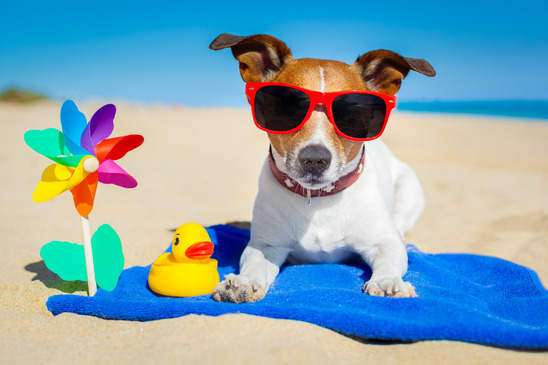The sun-soaked days of summer bring about an air of excitement and adventure, not only for us but also for our faithful furry companions. However, as the temperatures soar, it becomes imperative to address a critical aspect of responsible pet ownership: keeping our beloved dogs cool and comfortable. While summer is a season of outdoor escapades and bonding moments, it also presents certain challenges that can impact the well-being of our canine friends.
As temperatures rise, the heat sensitivity of dogs becomes more pronounced. Unlike humans, dogs do not possess an efficient cooling system through sweating. Instead, they rely primarily on panting and limited sweat glands in their paw pads to regulate their body temperature. This fundamental physiological difference makes them particularly vulnerable to heat-related stress and illnesses. Ensuring that our dogs stay cool isn’t just a matter of comfort; it’s a crucial element of safeguarding their health and vitality.
The consequences of overheating in dogs can range from mild discomfort to severe, life-threatening conditions. Heat exhaustion and heatstroke are real dangers that can creep up quickly, even in the most energetic and robust canines. Symptoms like excessive panting, drooling, lethargy, rapid heartbeat, and disorientation may signal the onset of heat-related distress. Prolonged exposure to high temperatures can lead to irreversible organ damage or, in the worst cases, fatalities.
The upcoming sections of this article will delve into practical strategies and essential tips for ensuring your four-legged friend’s well-being in the sweltering heat. By understanding the unique challenges that summer poses to our canine companions and by implementing the right precautions, you can create a safe and enjoyable environment that allows your dog to thrive throughout the sunny season.
Understanding Canine Heat Sensitivity
Factors That Contribute to Dogs’ Heat Sensitivity
A variety of factors contribute to dogs’ susceptibility to heat-related issues. Size, age, breed, and overall health play integral roles in how well a dog can handle elevated temperatures. Smaller breeds and puppies have a higher surface area-to-body mass ratio, making them more prone to rapid heat absorption. Senior dogs might have diminished heat-regulating capabilities due to age-related physiological changes. Additionally, dogs with certain medical conditions like obesity, heart problems, or respiratory issues are at an elevated risk of heat stress.
Breeds That Are Particularly Prone to Heat Stress
While all dogs require precautions in hot weather, some breeds are inherently more predisposed to heat sensitivity. Brachycephalic breeds, such as Bulldogs, Pugs, and Boston Terriers, have shortened snouts and narrower airways, making it harder for them to pant efficiently. Long-haired breeds, like Huskies and Malamutes, have dense fur coats that can trap heat close to their bodies. Recognizing your dog’s breed-specific characteristics will help you tailor your approach to keeping them cool.
Signs of Heat Exhaustion and Heatstroke in Dogs
Knowing the signs of heat-related distress is vital for early intervention. Heat exhaustion is characterized by heavy panting, excessive drooling, weakness, vomiting, and diarrhea. If left unchecked, it can escalate into heatstroke, which is a medical emergency. Signs of heatstroke include rapid heart rate, glazed eyes, lethargy, staggering, confusion, and even collapse. If you suspect your dog is experiencing heat-related issues, it’s crucial to take immediate action by moving them to a cooler area, providing water, and seeking veterinary attention.
By comprehending the factors influencing your dog’s heat sensitivity, understanding the breeds at higher risk, and recognizing the signs of heat-related problems, you can be better equipped to create a safe and comfortable environment for your canine companion during the scorching summer months. In the next sections, we’ll explore actionable steps you can take to ensure your dog’s well-being and beat the heat together.
Creating a Cool Environment
Providing Shade in Outdoor Spaces
When your furry friend wants to bask in the backyard, ensure they have access to ample shade. Position outdoor activities under trees, awnings, or use portable sunshades to create comfortable spots where your dog can relax without direct exposure to the sun. A well-shaded area not only shields your pet from the heat but also encourages them to engage in their natural behavior while staying cool.
Setting Up a Designated Cool Area Indoors
Inside your home, designate a cool, well-ventilated space where your dog can retreat to when the temperatures rise. A room with good airflow or a shaded corner can serve as a haven from the heat. Keep windows open to promote cross-ventilation, and if possible, use fans to circulate air. Providing fresh water in this area ensures your dog stays hydrated, even when indoors.
Using Cooling Mats and Elevated Beds
Investing in cooling mats and elevated beds can offer your dog additional relief from the heat. Cooling mats are designed to absorb and dissipate heat, providing a cool surface for your dog to lie on. These mats can be placed indoors or outdoors and are particularly useful for dogs who prefer lying on cooler surfaces. Elevated beds, with their raised design, allow air to circulate underneath, preventing heat from accumulating around your pet.
In the upcoming sections, we’ll explore other essential aspects of summer safety for dogs, including hydration strategies, mindful exercise routines, and grooming practices that contribute to their overall well-being during the warmer months. By thoughtfully crafting their environment, you ensure your canine companion remains comfortable and content despite the soaring temperatures.
Proper Hydration
Importance of Sufficient Water Intake
Just as hydration is vital for humans, it’s equally crucial for our canine companions, especially during the heat of summer. Adequate water intake helps regulate body temperature, aids in digestion, and supports overall organ function. Dogs can lose fluids quickly through panting and sweating from their paw pads, making it imperative to provide them with a constant source of fresh, clean water.
Tips for Encouraging Your Dog to Drink More Water
- Frequent Water Availability: Ensure multiple water bowls are placed throughout your home, both indoors and outdoors. This makes it convenient for your dog to access water wherever they are.
- Cool and Fresh Water: Change the water frequently to keep it cool and appealing. Dogs are more likely to drink water that is clean and refreshingly cold.
- Flavored Water: Adding a small amount of low-sodium chicken or beef broth to their water can make it more enticing for your dog.
- Interactive Fountains: Some dogs are intrigued by the sound and movement of flowing water, making a pet water fountain a fun and engaging way for them to drink.
DIY Frozen Treats and Ice Cubes for Added Hydration
Beat the heat with delicious and hydrating treats that your dog will love:
- Frozen Treats: Create frozen treats by blending dog-safe ingredients like plain yogurt, mashed fruits (e.g., berries, watermelon), and a touch of honey. Pour the mixture into ice cube trays or specialized treat molds and freeze.
- Pup-sicles: Freeze a mixture of water and small dog treats in silicone molds. This not only cools your dog down but also offers a tasty surprise.
- Fruit Ice Cubes: Drop small pieces of dog-safe fruits (e.g., apple slices, blueberries) into ice cube trays, fill with water, and freeze. These fruit-infused ice cubes add flavor and hydration.
By focusing on proper hydration through accessible water sources, enticing drinking strategies, and creative frozen treats, you can keep your dog’s thirst quenched and help them stay cool and comfortable throughout the sweltering summer. The next sections will delve into mindful exercise practices, grooming techniques, and precautions to ensure safe outdoor adventures for your furry companion.
Mindful Exercise and Activity
Choosing Optimal Exercise Times (Early Morning or Late Evening)
When the sun is at its peak, the pavement can become scorching and the air stifling, making it unsafe for strenuous physical activity. To keep your dog cool and avoid overheating, schedule outdoor exercise during the cooler parts of the day: early morning or late evening. During these times, temperatures are more bearable, reducing the risk of heat-related stress and ensuring a more comfortable experience for your furry friend.
Adjusting Intensity and Duration of Physical Activities
Tailor your dog’s exercise routine to the weather conditions. Opt for gentler activities like leisurely walks, short play sessions, or casual fetch games. Be mindful of signs of fatigue, excessive panting, or discomfort. If you notice any of these cues, it’s time to take a break and allow your dog to rest in a shaded area.
Engaging in Mentally Stimulating Indoor Games
On exceptionally hot days, when outdoor activities are limited, engage your dog’s mind with stimulating indoor games. Puzzle toys, hide-and-seek, and interactive treat-dispensing toys challenge their cognitive skills while keeping them entertained and mentally sharp. Mental engagement can be just as satisfying as physical exertion and helps prevent boredom during times of restricted outdoor play.
As we move forward, we’ll explore effective grooming practices that aid in temperature regulation and comfort for your dog. Grooming isn’t just about aesthetics – it plays a vital role in maintaining their well-being, especially when the sun is blazing.
Grooming and Coat Care
Regular Brushing to Prevent Matting and Improve Airflow
Regular grooming plays a pivotal role in your dog’s comfort during the summer. Brushing your dog’s coat helps prevent matting, which can trap heat and moisture close to the skin, leading to discomfort and potential skin issues. Frequent brushing removes loose fur, allows air to circulate, and helps maintain a healthy coat. Use a suitable brush for your dog’s coat type, and pay special attention to areas prone to tangles, such as behind the ears and under the armpits.
Trim or Clip Long-Haired Breeds for Better Heat Dissipation
For long-haired breeds, consider a strategic trim or clipping to help them stay cool. Consult a professional groomer to determine the optimal length for your dog’s coat. Trimming excessive fur not only promotes better heat dissipation but also reduces the weight of the coat, preventing your dog from feeling weighed down and overheated.
Avoiding Shaving Certain Breeds That Have Protective Coats
While it might seem counterintuitive, not all dogs should be shaved during the summer. Some breeds have coats that act as natural insulation, protecting them from both heat and harmful UV rays. Breeds like the Siberian Husky, Australian Shepherd, and Bernese Mountain Dog have coats designed to keep them cool in hot weather and warm in cold weather. Shaving these breeds can disrupt their natural cooling mechanism and even increase the risk of sunburn. Consult a veterinarian or experienced groomer to determine the best grooming approach for your specific breed.
In the following sections, we’ll explore the critical aspects of keeping your dog hydrated, practicing mindful exercise routines, and ensuring a safe environment during car travel. By taking a holistic approach to summer safety for your furry friend, you can create lasting memories while prioritizing their well-being.
Grooming and Coat Care
Regular Brushing to Prevent Matting and Improve Airflow
Regular grooming plays a pivotal role in your dog’s comfort during the summer. Brushing your dog’s coat helps prevent matting, which can trap heat and moisture close to the skin, leading to discomfort and potential skin issues. Frequent brushing removes loose fur, allows air to circulate, and helps maintain a healthy coat. Use a suitable brush for your dog’s coat type, and pay special attention to areas prone to tangles, such as behind the ears and under the armpits.
Trim or Clip Long-Haired Breeds for Better Heat Dissipation
For long-haired breeds, consider a strategic trim or clipping to help them stay cool. Consult a professional groomer to determine the optimal length for your dog’s coat. Trimming excessive fur not only promotes better heat dissipation but also reduces the weight of the coat, preventing your dog from feeling weighed down and overheated.
Avoiding Shaving Certain Breeds That Have Protective Coats
While it might seem counterintuitive, not all dogs should be shaved during the summer. Some breeds have coats that act as natural insulation, protecting them from both heat and harmful UV rays. Breeds like the Siberian Husky, Australian Shepherd, and Bernese Mountain Dog have coats designed to keep them cool in hot weather and warm in cold weather. Shaving these breeds can disrupt their natural cooling mechanism and even increase the risk of sunburn. Consult a veterinarian or experienced groomer to determine the best grooming approach for your specific breed.
In the following sections, we’ll explore the critical aspects of keeping your dog hydrated, practicing mindful exercise routines, and ensuring a safe environment during car travel. By taking a holistic approach to summer safety for your furry friend, you can create lasting memories while prioritizing their well-being.
Avoiding Hot Pavement and Surfaces
Checking Pavement Temperature Before Walks
The pavement can absorb and radiate heat, reaching scorching temperatures that can burn your dog’s sensitive paw pads. Before embarking on a walk, place the back of your hand on the pavement for a few seconds. If it feels uncomfortably hot, it’s likely too hot for your dog’s paws. Opt for alternative surfaces or delay your walk until cooler hours.
Using Dog Booties or Paw Balms for Protection
Dog booties offer a layer of insulation between your dog’s paws and hot surfaces. They provide an effective barrier against heat and protect your dog’s feet from burns. If booties aren’t an option, consider applying a pet-safe paw balm before heading out. Paw balms create a protective layer, minimizing the risk of burns and keeping paw pads moisturized.
Opting for Grassy or Shaded Walking Routes
When planning your walking routes, prioritize grassy areas and shaded paths. Grass tends to stay cooler than pavement and provides a more comfortable surface for your dog to walk on. Shaded routes offer relief from direct sunlight, reducing the risk of overheating. Exploring parks or nature trails can provide a cooler and more enjoyable walking experience for both you and your canine companion.
In the upcoming sections, we’ll delve into safe car travel practices, the importance of cool treats, and recognizing the signs of heat-related distress in dogs. By implementing these precautions and strategies, you can ensure that your dog stays cool, comfortable, and safe throughout the summer months.
Cool Treats and Snacks
Preparing Homemade Frozen Treats with Dog-Safe Ingredients
Treat your dog to a delectable array of homemade frozen delights. Create simple and nutritious treats by blending ingredients like plain yogurt, pureed fruits (such as bananas or blueberries), and a dash of peanut butter. Pour the mixture into ice cube trays, silicone molds, or specialized dog treat molds and freeze. These icy treats provide a refreshing and hydrating snack that your dog will eagerly look forward to.
Choosing Commercial Frozen Treats with Natural Ingredients
If whipping up treats isn’t your forte, fear not—there are plenty of frozen treat options available in pet stores. Look for products with minimal, natural ingredients, avoiding those with added sugars, artificial flavors, or preservatives. Many pet brands offer frozen treats designed to cool and refresh your dog, making it convenient to provide a chilly indulgence on hot days.
Using Food-Dispensing Toys to Make Mealtime Engaging and Refreshing
Transform mealtime into an engaging activity with food-dispensing toys. These toys challenge your dog’s mental prowess as they work to extract kibble or treats. Fill these toys with a portion of their daily meal and freeze them before offering to your dog. The combination of a mental challenge and the cool sensation of the frozen food makes for a satisfying and refreshing experience.
As we move forward, we’ll delve into crucial information about recognizing severe signs of heat-related distress, providing first aid for heat exhaustion and heatstroke, and when to seek professional veterinary care. Your dedication to creating a cool and safe summer environment for your canine companion will ensure their well-being and happiness throughout the season.
Knowing When to Seek Veterinary Care
Recognizing Severe Signs of Heat-Related Distress
While preventative measures are crucial, it’s equally important to be vigilant for signs of severe heat-related distress in your dog. Symptoms may escalate quickly and demand immediate attention. Watch for indications such as excessive panting, rapid heartbeat, drooling, weakness, vomiting, diarrhea, glazed eyes, confusion, staggering, and even collapse. If your dog exhibits any of these symptoms, it’s a red flag that they may be experiencing heat exhaustion or heatstroke.
First Aid Steps for Heat Exhaustion and Heatstroke
In the event of heat-related distress, swift action can be lifesaving. If you suspect your dog is suffering from heat exhaustion or heatstroke:
- Move your dog to a shaded, cool area immediately.
- Offer small amounts of water to drink.
- Use cool (not cold) water to wet their body, especially the head, neck, and paw pads.
- Place a damp cloth or cool pack on their groin area and under their armpits.
- Use a fan or air conditioning to further cool them down.
- Avoid using ice or very cold water, as rapid cooling can shock their system.
Consulting a Veterinarian for Professional Guidance
While your quick response can help alleviate heat-related distress, it’s essential to consult a veterinarian for professional guidance and assessment. Heatstroke can lead to internal complications that may not be immediately apparent. A veterinarian can conduct thorough examinations, administer appropriate treatments, and monitor your dog’s recovery. Timely veterinary care significantly increases the chances of a full and safe recovery.
As we conclude this guide, remember that your dedication to understanding and implementing these strategies ensures your dog’s comfort, safety, and happiness during the hot summer months. By keeping them cool and well-cared for, you’re fostering a strong bond and enriching the shared experiences that make the season enjoyable for both you and your four-legged friend.
Conclusion
A. Recap of Key Strategies for Keeping Dogs Cool in the Summer
As the summer sun shines brightly, ensuring your dog’s well-being is paramount. By following these key strategies, you can create a safe and enjoyable summer experience for your furry companion:
- Prioritize proper hydration with accessible water sources and creative treats.
- Mindfully adjust exercise routines to avoid the heat of the day.
- Maintain grooming and coat care routines to promote comfort and cooling.
- Protect paws from hot surfaces and opt for shaded walking routes.
- Recognize signs of heat-related distress and take immediate action when needed.
Responsible pet ownership extends beyond providing love and companionship. It involves taking proactive steps to safeguard your dog’s health, happiness, and safety, especially during challenging weather conditions. Your commitment to understanding and implementing these strategies reflects your dedication to being a caring and attentive pet guardian.
Summer offers a unique opportunity to forge unforgettable memories with your dog. Whether it’s exploring new trails, engaging in fun games, or simply lounging together in the shade, these shared experiences strengthen the bond between you and your furry friend. By prioritizing their well-being and ensuring their comfort, you’re nurturing a deep and lasting connection that enriches both of your lives.
As you embark on your summer adventures, remember that your furry companion relies on you for their safety and happiness. With the knowledge and insights gained from this guide, you’re well-equipped to create a summer full of joyful moments, cherished memories, and the utmost care for your beloved dog.










